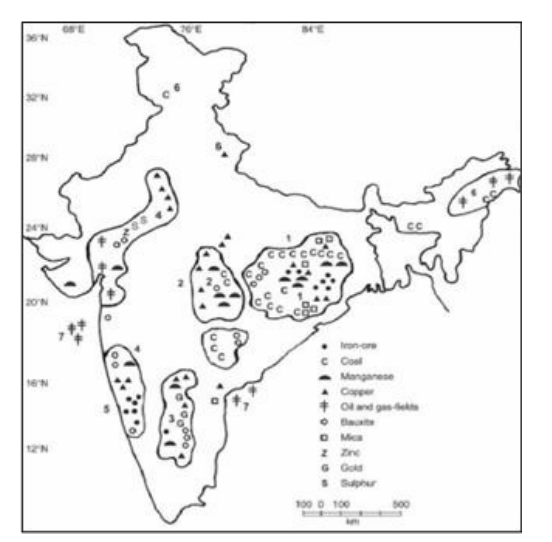
India, a land of diverse landscapes and geological marvels, is bestowed with a treasure trove of rich mineral resources owing to its intricate geological structure. The subcontinent’s geological diversity has given rise to numerous mineral belts, each showcasing a distinct array of valuable resources. From the towering peaks of the Himalayas to the expansive Deccan Plateau, India’s geological tapestry is marked by the presence of large mineral belts that play a crucial role in shaping the nation’s economy. These mineral-rich zones, including the Singhbhum Copper Belt, the Chota Nagpur Plateau, and the Western Ghats, serve as vital hubs for the extraction of minerals, fostering economic growth and contributing significantly to India’s industrial development. The geological endowment of India stands as a testament to the country’s geological heritage, supporting various industries and catalyzing the nation’s progress.
Contents
Answer
India is bestowed with rich mineral resources due to its diverse geological structure. The country has a wide range of mineral belts, each with its own unique geological features and mineral deposits.

- North-Eastern Peninsular Belt
- This belt is located in the states of Jharkhand, West Bengal, and Odisha.
- It is known for its rich deposits of iron ore, coal, manganese, mica, and bauxite.
- The rich mineral deposits of the North-Eastern Peninsular Belt are closely associated with its geological structure
- The iron ore deposits are found in the Precambrian banded iron formations (BIFs). BIFs are sedimentary rocks that were formed over 2 billion years ago. They are rich in iron and other minerals, such as silica and manganese.
- The coal deposits of the North-Eastern Peninsular Belt are found in the Gondwana Supergroup-a sequence of sedimentary rocks that were formed during the Permian and Triassic periods (250- 200 million years ago). The Gondwana Supergroup is found in several basins in the NorthEastern Peninsular Belt, such as the Damodar Basin, the Mahanadi Basin, and the Son Basin.
- The mica deposits of the North-Eastern Peninsular Belt are found in the Precambrian pegmatites.
- Central Belt
- This belt is located in the states of Chhattisgarh, Madhya Pradesh, Telangana, Andhra Pradesh, and Maharashtra.
- It is known for its rich deposits of coal, iron ore, manganese, bauxite, limestone, and marble.
- It is a part of the Indian Craton, which is one of the oldest and most stable landmasses on Earth. The geological structure of the Central Belt is characterized by a complex system of faults and folds
- The iron ore deposits are found in the Precambrian banded iron formations (BIFs). BIFs are sedimentary rocks that were formed over 2 billion years ago
- The manganese deposits in the Precambrian Dharwad Supergroup, a sequence of volcanic and sedimentary rocks that were formed over 3 billion years ago
- The bauxite deposits of the Central Belt are found in the lateritic soils

- Southern Belt
- This belt is located in the states of Karnataka, Andhra Pradesh, Telangana, and Tamil Nadu.
- It is known for its rich deposits of iron ore, manganese, bauxite, limestone, and graphite.
- The rich mineral deposits of the Southern Belt are closely associated with its geological structure
- The limestone deposits are found in the Precambrian rocks.
- Limestone is a sedimentary rock that was formed from the accumulation of shells, skeletons, and other marine organisms.
- The graphite deposits are found in the Precambrian gneisses and schists. Graphite is a form of carbon that is found in metamorphic rocks.
- South-Western Belt
- This belt is located in the states of Karnataka, Kerala, and Goa.
- It is known for its rich deposits of iron ore, garnet, and clay.
- The rich mineral deposits of the South-Western Belt are closely associated with its geological structure
- The garnet deposits are found in the Precambrian gneisses and schists. Garnet is a mineral that is found in metamorphic rocks.
- The clay deposits are found in the lateritic soils. Lateritic soils are a type of soil that is formed in tropical and subtropical regions with high rainfall and temperatures.
- North-Western Belt
- This belt is located in the states of Rajasthan and Gujarat.
- It is known for its rich deposits of non-ferrous metals, such as copper, lead, and zinc, as well as uranium, aquamarine, petroleum, mica, beryllium, gypsum, and emerald.
- The rich mineral deposits of the North-Western Belt are closely associated with its geological structure
- The non-ferrous metal deposits, such as copper, lead, and zinc, are typically found in the Precambrian rocks of the region. These rocks were formed over 2 billion years ago subjected to a number of geological processes, including metamorphism and magmatism.
- The uranium deposits are found in the Precambrian sandstones of the region, formed from the erosion of the older Precambrian rocks and were deposited in sedimentary basins
- Aquamarine deposits are found in the pegmatite veins of the region, a type of igneous rock that is characterized by its large grain size.
It is important to manage the mineral resources of India sustainably. This includes ensuring that the resources are used efficiently and that the environment is protected. It also includes investing in research and development to find new and innovative ways to extract and use mineral resources.
In case you still have your doubts, contact us on 9811333901.
For UPSC Prelims Resources, Click here
For Daily Updates and Study Material:
Join our Telegram Channel – Edukemy for IAS
- 1. Learn through Videos – here
- 2. Be Exam Ready by Practicing Daily MCQs – here
- 3. Daily Newsletter – Get all your Current Affairs Covered – here
- 4. Mains Answer Writing Practice – here

